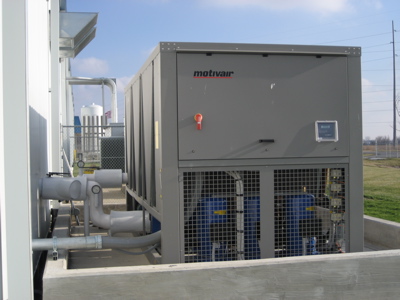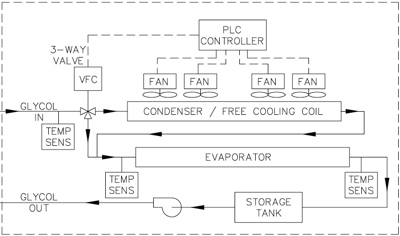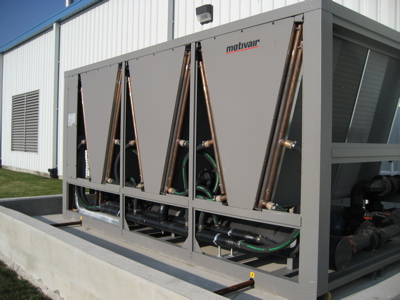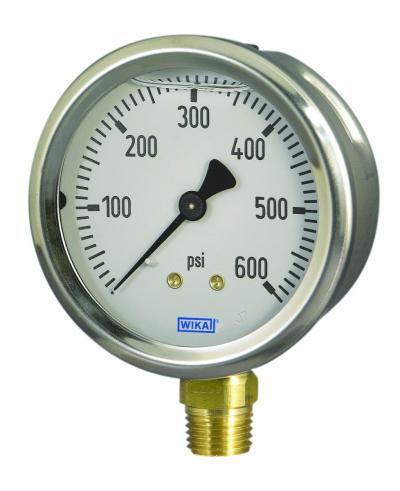Industrial plants are major consumers of water. Water is used in many processes. Sustainability projects focus on reducing the consumption of water and the energy-costs associated with cooling water so it may be effectively used. This month, we received case studies from Motivair Corporation and from WIKA Instrument Corporation providing examples on how to use chillers to reduce energy costs and water consumption.
Part 1: Motivair Free-Cooling Chiller Saves Energy at a Tube Mill
The extensive water-cooled hydraulics and product quenching system at the tube mill requires year-round cooling. The optimum cooling water temperature is around 70 °F – too low for any type of cooling tower or dry cooler (radiator) system. The cooling water needed to be approximately 10 °F lower, in order to ensure the correct temperature of 70 °F to the process. 60 °F was specified as the required year-round water temperature from the chiller, returning to the chiller at 70 °F.
The entire hydraulic/product quenching cooling system is fed from two plate & frame heat exchangers inside the plant on a closed loop recirculating system.

Motivair Free-Cooling Chiller Installed at a Steel Tube Mill
The tube mill planned to install a nominal 100-ton refrigeration water chiller to handle the cooling load. Mechanical (refrigeration) cooling is significantly more expensive to operate than radiators or cooling towers but there was no other alternative for guaranteed year round water at this location.
The tube mill researched the possibilities and settled on a Motivair Free Cooling chiller. Free Cooling chillers are outdoor, packaged air-cooled chillers with integrated free cooling coils, motorized 3-way valve and custom PLC controls. The design allows year-round cooling applications to reduce energy costs by taking advantage of low ambient temperatures. Therefore these chillers are best applied in the central and Northern states of the USA, Canada & Europe.
When the outdoor ambient is lower than the return chilled water, the 3-way valve diverts the water through the free cooling coils positioned across the face of the air cooled condenser coils. The condenser airflow, which is common to both coils, pre-cools the water before it enters the chiller evaporator, reducing the cooling load. As the ambient temperature falls, the pre-cooling effect is increased and the refrigeration compressors are unloaded or switched off.
A typical design provides 50% free cooling when the ambient air is 10 °F below the supply chilled water temperature and 100% free cooling with a 20 °F differential. The entire operation is completely automatic and provides a seamless transition in and out of free cooling with no temperature spikes. A glycol solution is mandatory to prevent freezing, since the chiller is required to operate outdoors, throughout the winter months.
These chillers can be applied to any industrial process that requires year-round cooling, including Hydraulics, plastic molding, chemical, food & pharmaceutical production. The power savings are significant and easily justify the added expense of a free cooling system. A secondary, but significant advantage is the refrigeration compressors are not required to operate in low ambient conditions - the worst operating condition for any refrigeration compressor. The elimination of low ambient operation reduces nuisance downtime in winter and extends the equipment life through reduced operating hours and optimized running conditions.

Motivair Free-Cooling Chiller Process Diagram
Given the annual temperature range in this area, the savings were readily apparent. Whenever the outside air temperature falls below 70 °F, the return chilled glycol solution is automatically diverted through the integrated Free Cooling coils of the chiller. These coils are located across the inlet-air side of the air-cooled condensers and use the condenser fans to pre-cool the return glycol. As the ambient temperature falls, the pre-cooling increases - until at approximately 20 °F below the supply glycol temperature - the chiller operates entirely without compressors.
From historical 30-year weather data, the area experiences approximately 500 hours/year at 50-55 °F (25% free cooling); 1,052 hours at 41-50 °F (50% free cooling) and 3,484 hours below 41 °F (100% free cooling) See attached chart. The total installed refrigeration compressor power in the chiller is 112 kW. At a power cost of \$0.07/kWh the power savings for the tube mill were calculated to be approximately \$32,412 per year, compared to the same capacity chiller without free cooling. The payback period for the free cooling option was less than the first year of operation.
Free cooling chiller savings are increased in colder climates and when higher chilled water temperatures are used. When both of these parameters are optimized the energy savings are increased proportionally.

Hydraulic Hose Glycol Connections to the Integrated Free-Cooling Coils
Part 2: WIKA Plant in Georgia Reduces Water Consumption
WIKA Instrument Corporation (WIKA) has further reduced water consumption at its Lawrenceville, GA., pressure and temperature instrumentation manufacturing facility from 70 to 78 percent from May 2007 to December 2009.
In May 2007, a typical workday’s daily water usage was 60,305 gallons/day and a monthly usage per thousand pieces produced was 641 gallons. In December 2009, a typical workday’s water usage was 13,194 gallons/day and a monthly usage per thousand pieces produced was 193 gallons.

Chillers Reduced Water Consumption at WIKA
In 2007, an interdepartmental project team identified and implemented water reduction methods to conserve water and in return, save the company money. The return on investment on these implementations was realized in less than one year’s time. The amount of water saved annually resulted in 10.5 million gallons— enough to fill more than 16 Olympic-sized swimming pools.
The most dramatic solution implemented was the installation of ten (10) industrial “chillers”. Before the chillers were installed, water was used to cool the fixtures and transformer. This water was used once and sent to the sewer. The chillers reduce our water consumption because they recirculate water, which cools the facility’s 15 resistance and conductive soldering stations. The cooling temperature has to be 72 °F constant. The installation of the chillers allowed us to establish a closed loop system by regulating the temperature of recirculated water. WIKA also installed a “chiller” on another component in its factory that cools water from a washing operation.
The industrial chiller used was a Koolant Kooler, model #JT500. The ROI was determined based on the cost of incoming water and the amount of water we saved. Calculating the individual monthly savings compared to our “before” usages indicated we saved \$39,000 on water bills in the first year. We purchased 10 chillers at \$2900, totaling \$29,000. The simple ROI was therefore less than one year.

WIKA Instruments manufactures pressure and temperature instruments at its’ Lawrenceville, Georgia facility
For more information contact Rod Smith, Compressed Air Best Practices®, tel: 412-980-9901, email: rod@airbestpractices.com
For Motivair Free-Cooling Chillers contact: Graham Whitmore, tel: 716-689-0222, email: gwhitmore@motivaircorp.com, www.motivaircorp.com
For WIKA Instruments contact: Melissa Smith, tel: 678-739-2571, email: msmith@wika.com, www.wika.com




